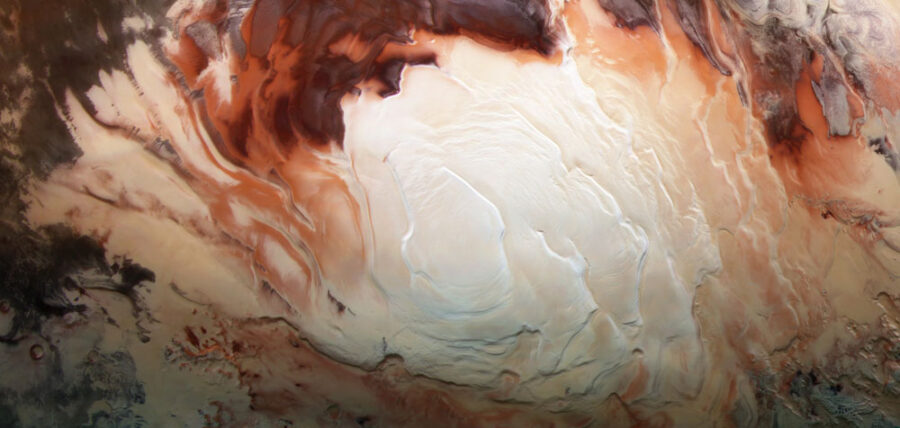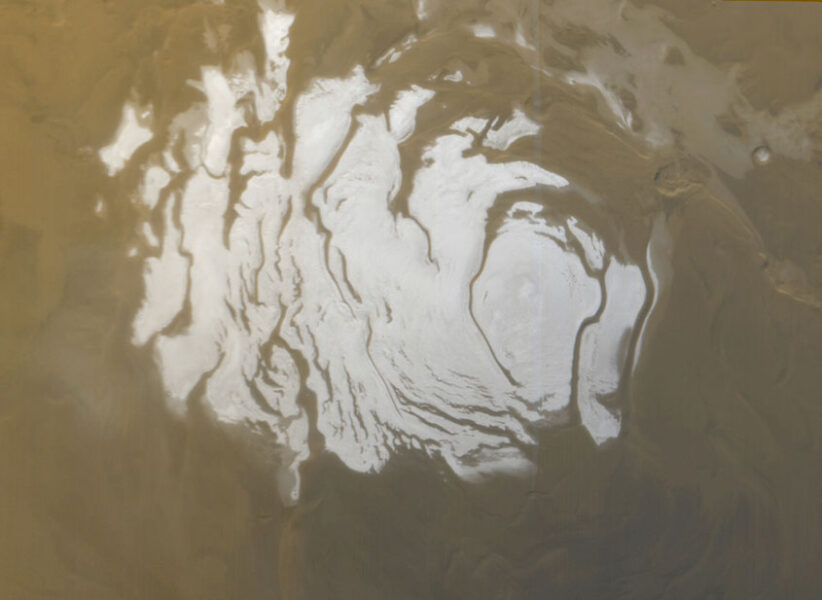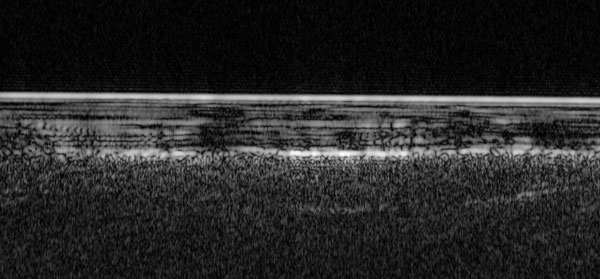New analysis of data from the European Space Agency’s Mars Express orbiter strengthens the case for salty lakes underneath Mars’s south polar cap.

ESA / DLR / FU Berlin / Bill Dunford
Remember the possible saline lake found underneath Mars’s south pole? New analysis of data from the European Space Agency’s Mars Express has made that conclusion more plausible — with a little help from underground lakes in Greenland.
About two years ago, scientists announced the exciting discovery of a bright reflecting sheet underneath the layered dusty ice of Mars’ south polar cap. The team behind that discovery, led by Roberto Orosei (National Institute of Astrophysics, Italy), examined 29 radar images from the Mars Express orbiter, which had crisscrossed the region over four years.
New work published in Nature Astronomy by Sebastian Lauro (Roma Tre University, Italy) and colleagues — all working in the same research group as the team that made the initial discovery — examines an 134 radar images taken over 10 years.
The researchers not only confirmed the probable presence of a lake, they found that it has friends: the “large body of water [is] encircled by patchy water pools or wet areas of smaller extent,” they write. The largest putative lake is about 20 kilometers (12 miles) across; the smaller patches appear as 5- to 15-kilometer-wide spots.
What Greenland and Mars Have in Common

NASA / JPL / MSSS
The new work does not just improve on the prior work by adding more data. The team also employed a totally different analysis technique, originally developed for use on Earth.
The first detections of subglacial lakes on our home planet came from evidence for large, isolated bodies of water underneath Antarctic ice sheets. But the detection methods developed for Antarctica failed to work in Greenland, where the subglacial water is patchy, intermixed with areas of either permafrost or dry sub-ice conditions.
So Earth scientists working in Greenland developed a new method to search for subglacial liquids. They looked not only at the brightness of the reflection — as Orosei and coworkers did in the 2018 study — but also at the smoothness of the reflection surface and how those qualities varied from spot to spot. They found that brightly reflective places also tended to be very smooth. These regions also had relatively constant brightness and smoothness, while the qualities varied more outside them. Here on Earth, under Greenland’s ice, this correlation is good evidence for the presence of sub-glacial lakes. At Mars, the same is probably true.
The Prospects for Water, and for Life

ESA / NASA / JPL / ASI / Univ. Rome; R. Orosei et al. 2018
There remains the problem of explaining how Mars can host liquids beneath the layered deposits at its south pole, where the temperatures must be very, very low, possibly as low as 150 K (-120°C or -190°F). Some researchers argue that’s just too cold: There would have to be extra heat coming from deep beneath the surface, possibly from volcanism. Others point to experiments showing that hypersaline brines, carrying large quantities of salty minerals like the perchlorates that Phoenix found at its polar landing site, can have very low melting temperatures. Moreover, such brines are capable of supercooling (remaining liquid at temperatures below their melting points).
Ultimately, the conditions that are enabling this underground water source to remain liquid are “at best, a matter of speculation at this point in time,” the researchers write. Regardless of how liquids exist, the evidence for sub-ice liquid water ponds is strong.
Such ponds could serve as refugia for Martian life. Hypersaline liquids are not every microbe’s paradise, but there are extremophiles that thrive in similar (though, admittedly, not as cold or as saline) environments on Earth. Under their thick blankets of dust and ice, any Mars life in such a lake would be protected both from the harmful effects of cosmic rays and from seasonal variations in temperature. It would be cold, and dark, and exceedingly salty, but stable and safe from environmental change.
They’d also be hard to reach, lying more than 1,200 meters (4,000 feet) beneath alternating layers of ice and dust in one of the coldest locations on Mars. The protective blanket of layered deposits would protect any Martian life from human interest, for now. But someday, we may send a submersible to explore this sheltered Martian habitat. Just imagine what we could find down there.
Emily Lakdawalla is a planetary scientist, science writer, and space artist. Her first book, The Design and Engineering of Curiosity, was published by Springer-Praxis in 2018. A sequel, Curiosity and Its Science Mission, will be published in 2021.
 1
1









Comments
Randy Pfeiffer
October 2, 2020 at 4:12 pm
"...remaining liquid at temperatures below their melting points". Presumably this should be freezing points.
You must be logged in to post a comment.
You must be logged in to post a comment.